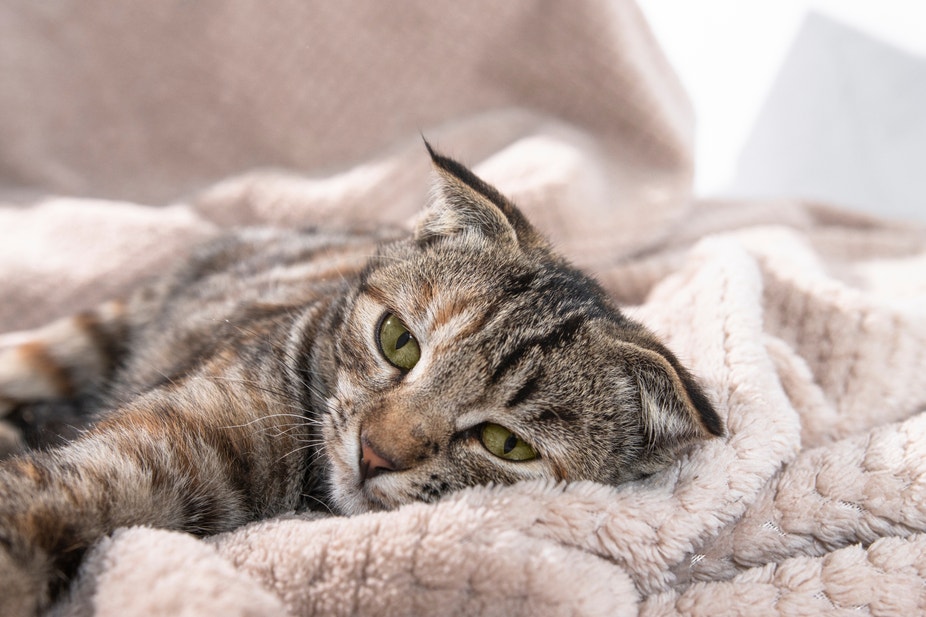
CAT FLU: SIGNS, TREATMENT & HOME CARE

Article checked by a vet
Like us, cats can get a cold like flu that can give them symptoms including a runny nose, sore eyes and a fever.
However, although cat flu is rarely life threatening in healthy adult cats, it is quite a serious illness. Some cats end up with lifelong health problems after having flu, and some vulnerable cats can die from it. As such, it’s important for all cat parents to understand the risk of cat flu and recognise the signs of it.
The cats that are most at risk from cat flu are young and old cats, and cats with underlying health conditions.
In this guide, we’ll look at cat flu, explaining what it is, cat flu symptoms, cat flu treatment, how to care for a cat with flu and how it can be prevented with vaccinations.
What are the first signs of cat flu?
- Sneezing
- Runny nose/nasal discharge and eye mucus
- Your cat not eating or eating less than usual
- Sleeping more than usual
- Shivering
While the symptoms may look like harmless cat cold-like symptoms, cat flu should be taken seriously.
Kittens are particularly vulnerable to cat flu. As such, kittens can only go outside(open in new tab) when they’re fully vaccinated against it.
Cat flu symptoms
Cat flu symptoms vary from mild to severe and affect different areas of a cat’s body. In many cases, the symptoms appear similar to those of a common cold in humans.
Be aware, however, that cat flu needs to be taken seriously. You should contact your vet if you think your cat might have cat flu.
Symptoms tend to be most obvious in the eyes, mouth and nose, and because their sense of smell is affected, cats’ appetites are usually affected as well.
Upper respiratory & nasal signs
Cat flu is primarily a respiratory infection, and the symptoms are most obvious in the mouth, nose and breathing.
Here are the common upper respiratory and nasal signs of cat flu:
- Sneezing
- Nasal discharge
- Congestion
- Unusual breathing noises – laboured breathing can be a cause for particular concern
- Loss of voice
- Sore throat (evident in swallowing or gagging)
- Coughing
If you see any of these cat cold-like symptoms and suspect your cat might have the flu, it’s important to call your vet. This is particularly important with vulnerable cats, such as kittens, elderly cats and cats with underlying health conditions that weaken the immune system.
Do cats get cold?(open in new tab) Cats feel the cold, and just like humans, having a warm, relaxing home environment will help them stay fit and healthy during the winter months.
Ocular signs
As well as cat cold-like symptoms, cats also often get symptoms in their eyes when they have the flu.
Here are the common ocular signs of cat flu:
- Discharge from their eyes and nose
- Painful eyes
- Red and swollen eyes
- Eyes partially closed or fully closed
- Corneal ulcers
Cats are vulnerable to eye infections when they have the flu, which in some cases can result in serious ulcers. In the worst cases, cats can suffer permanent eye damage or even lose an eye as a result of these infections.
Appetite, mouth & systemic signs
Cat flu also often affects the appetite and the overall health of a cat. In particular, it’s common for cats to lose their appetite when they have the flu.
Here are the main appetite, mouth and systemic signs of cat flu:
- Loss of appetite
- Mouth ulcers (common with the feline calicivirus flu variant)
- Dribbling
- Tiredness and low energy
- Shivering / fever
It’s important for cats to eat enough to help their recovery. In the next section, we’ll tell you a few things you can do to encourage your cat to eat more food while it has the flu.
Cat flu is one of many possible reasons why a cat is not eating(open in new tab).
Cat flu treatment options
There is no cure for cat flu, but vets do have some treatments that can help a cat recover faster and ease the symptoms.
You should always speak to your vet if you think your cat might have cat flu.
The most common cat flu treatments vets prescribe are:
- Anti-inflammatories – these lower a cat’s temperature and reduce inflammation.
- Decongestants to help loosen up mucus – this helps a cat to breathe more easily. Often, this will improve its appetite.
- Eye drops – lubricating or antibiotic eye drops are prescribed to soothe sore eyes or combat eye infections.
- Antibiotics – vets may also prescribe antibiotics where flu causes secondary bacterial infections.
- Antivirals – these are used in severe cases
Vets may also prescribe other treatments, depending on the condition of the cat and the variant of flu it has.
Most of the time, cats only need to be treated at home. However, in particularly bad cases, they have to be taken to the vets for care. Often, this is when they are unable to feed properly.
Cat flu treatment at home
You can help your cat recover from flu by following a good at-home care routine:
- Keep stress low – cats are vulnerable to stress, and it can make a cat more ill or hinder its recovery. Give your cat somewhere quiet and comfortable to rest, and try to keep stress to a minimum.
- Clear your cat’s nose and eyes – Gently clean your cat’s eyes and nose with cotton wool and warm water. This will help it breathe more easily and make it feel better. Importantly, it will also help your cat to smell food, which will increase its appetite.
- Encourage your cat to eat and drink – Encouraging your cat to eat and drink sufficiently will help it to recover faster. Give your cat easy access to clean, fresh water, and offer it tasty food that smells strongly and is easy to eat. Some good foods for cat flu treatment at home are oily fish (sardines, tuna, etc), chicken and warmed-up wet cat food.
- Help your cat breathe – Some people take their cat into the bathroom and run the shower because the steam helps them breathe more easily. However, be careful not to stress your cat with this treatment.
Prevention & vaccination
The best cat flu treatment is prevention with vaccines.
Flu vaccinations do not make cats immune to flu, but they do significantly reduce the risk of infection as well as the severity of illness if they do become infected.
Here is the normal kitten and cat vaccination schedule:
- First vaccine at nine weeks
- Booster at around three months
- Regular boosters once per year after this
Speak to your vet for an exact schedule. Kittens should always be kept inside until they are fully vaccinated.
All cats should be kept up to date with flu vaccines because flu can cause serious health conditions in cats of any age. However, it’s particularly important to make sure that kittens, old cats and cats with underlying health conditions get all their injections because they are more vulnerable.
Find out more about vaccinations for your new kitten(open in new tab).
Some cats that catch the flu will, unfortunately, go on to become carriers of the disease. In some cases, this will mean they have flare ups from time to time. However, in more severe cases, some cats will have symptoms, such as a runny nose, permanently. These cats can be helped by following good hygiene practices and keeping stress to a minimum.
